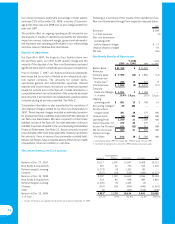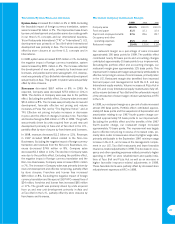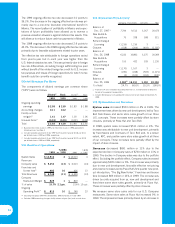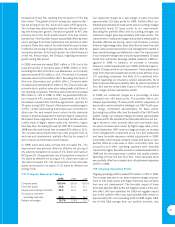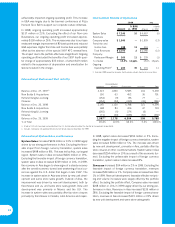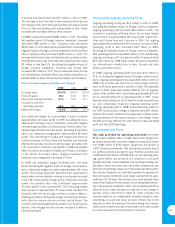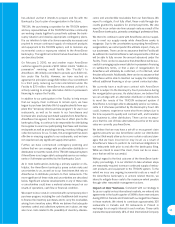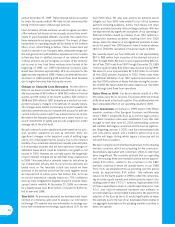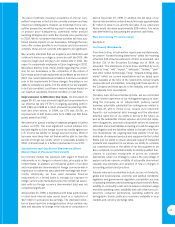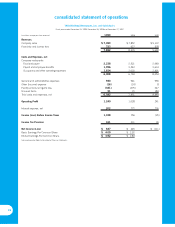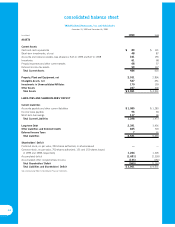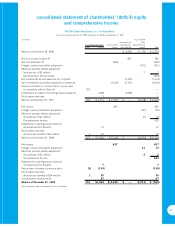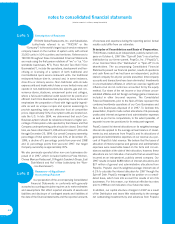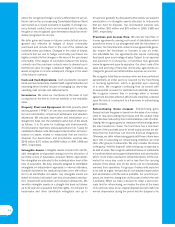Pizza Hut 1999 Annual Report Download - page 36
Download and view the complete annual report
Please find page 36 of the 1999 Pizza Hut annual report below. You can navigate through the pages in the report by either clicking on the pages listed below, or by using the keyword search tool below to find specific information within the annual report.
In 1998, net cash provided by operating activities decreased
$136 million to $674 million. Cash used for working capital was
$106 million for 1998 compared to cash provided by working
capital of $27 million in 1997. The 1998 use was primarily due
to an increase in current deferred tax assets and reduced
income taxes payable. Excluding net changes in working cap-
ital, net income before facility actions and all other non-cash
charges was essentially unchanged despite the net decline of
over 1,700 Company restaurants. The decline was driven by
our portfolio activities.
Cash provided by investing activities increased
$220 million to $522 million in 1999. The majority of the
increase is due to higher gross refranchising proceeds and pro-
ceeds from the sale of international short-term investments in
connection with a planned tax-efficient repatriation to the U.S.
We look at refranchising proceeds on an “after-tax” basis. We
define after-tax proceeds as gross refranchising proceeds less
the settlement of working capital liabilities related to the units
refranchised, primarily accounts payable and property taxes, and
payment of taxes on the gains. This use of proceeds reduces our
normal working capital deficit as more fully discussed above. The
after-tax proceeds are available to pay down debt or repurchase
shares. The estimated after-tax proceeds from refranchising of
$683 million in 1999 increased approximately 13% compared
to prior year. This increase is due to the increased number of
units refranchised as well as the mix of units sold and the level
of taxable gains from each refranchising.
In 1998, net cash provided by investing activities decreased
$164 million to $302 million compared to $466 million in 1997.
The 1998 decrease was primarily due to the prior year sale of
the Non-core Businesses partly offset by increased proceeds
from refranchising and the sales of property, plant and equip-
ment. Capital spending decreased by $81 million or 15%.
Net cash used for financing activities was essentially
unchanged at $1.1 billion in 1999. Payments on our unse-
cured Term Loan Facility and our unsecured Revolving Credit
Facility totaled $1.0 billion.
In September 1999, the Board of Directors authorized the repur-
chase of up to $350 million of the Company’s outstanding
Common Stock. Through December 25, 1999, 3.3 million shares
were repurchased under this program at a cost of $134 million.
We have repurchased approximately 3.4 million additional shares
for approximately $125 million through February 25, 2000.
In 1998, net cash used for financing activities of $1.1 billion
decreased slightly compared to 1997. The 1998 use repre-
sents net debt repayments. During 1998, we issued unsecured
notes resulting in proceeds of $604 million. These proceeds
were used to reduce existing borrowings under our unsecured
Term Loan Facility and unsecured Revolving Credit Facility.
Financing Activities
Our primary bank credit agreement, as amended in March 1999,
is currently comprised of a senior, unsecured Term Loan Facility
and a $3 billion senior unsecured Revolving Credit Facility
(collectively referred to as the “Credit Facilities”) which mature
on October 2, 2002. At December 25, 1999, we had approxi-
mately $774 million outstanding under the Term Loan Facility
and $955 million outstanding under the Revolving Credit
Facility. Amounts outstanding under our Term Loan Facility and
Revolving Credit Facility are expected to fluctuate from time to
time, but Term Loan Facility reductions cannot be reborrowed.
At December 25, 1999, we had unused Revolving Credit Facility
borrowings available aggregating $1.9 billion, net of outstanding
letters of credit of $152 million. We believe that we will be able
to replace or refinance our Credit Facilities with another form of
borrowing including a new credit facility or publicly issued debt,
depending on market conditions or terms available at that time.
We currently believe we will be able to replace or refinance the
Credit Facilities prior to the maturity date.
This substantial indebtedness subjects us to significant inter-
est expense and principal repayment obligations, which are
limited in the near term, to prepayment events as defined in
the credit agreement. Interest on the Credit Facilities is based
principally on the London Interbank Offered Rate (“LIBOR”)
plus a variable margin as defined in the credit agreement.
Therefore, our future borrowing costs may fluctuate depending
upon the volatility in LIBOR. We currently mitigate a portion of
our interest rate risk through the use of financial instruments.
See Notes 11 and 13 and our market risk discussion for further
discussions of our interest rate risk.
We anticipate that our 2000 combined cash flow from operating
and refranchising activities will be lower than 1999 levels
primarily because of our expectations of reduced refranchising
activity. However, we believe it will be sufficient to support our
expected capital spending and still allow us to make required
debt repayments and buy back shares under our current stock
repurchase program.
Consolidated Financial Condition
Assets decreased $570 million or 13% to $4.0 billion at year-
end 1999. This decrease is primarily attributable to the portfolio
effect and a decrease in cash and short-term investments. The
decrease in cash and short-term investments was primarily
driven by initiatives which allowed us to repatriate $210 million
of cash to the U.S. from foreign countries at minimal tax cost.
We continue to look for opportunities to tax efficiently repatri-
ate cash generated from foreign operations.
Liabilities decreased $1.2 billion or 21% to $4.5 billion pri-
marily due to net debt repayments.
Our operating working capital deficit declined 13% to $832 mil-
lion at year-end 1999 from $960 million at year-end 1998,
primarily reflecting the portfolio effect.
Other Significant Known Events, Trends or
Uncertainties Expected to Impact 2000 Ongoing
Operating Income Comparisons with 1999
Impact of AmeriServe Bankruptcy. As described in Note
22, on January 31, 2000, AmeriServe filed for protection
under Chapter 11 of the U.S. Bankruptcy Code. AmeriServe
34




